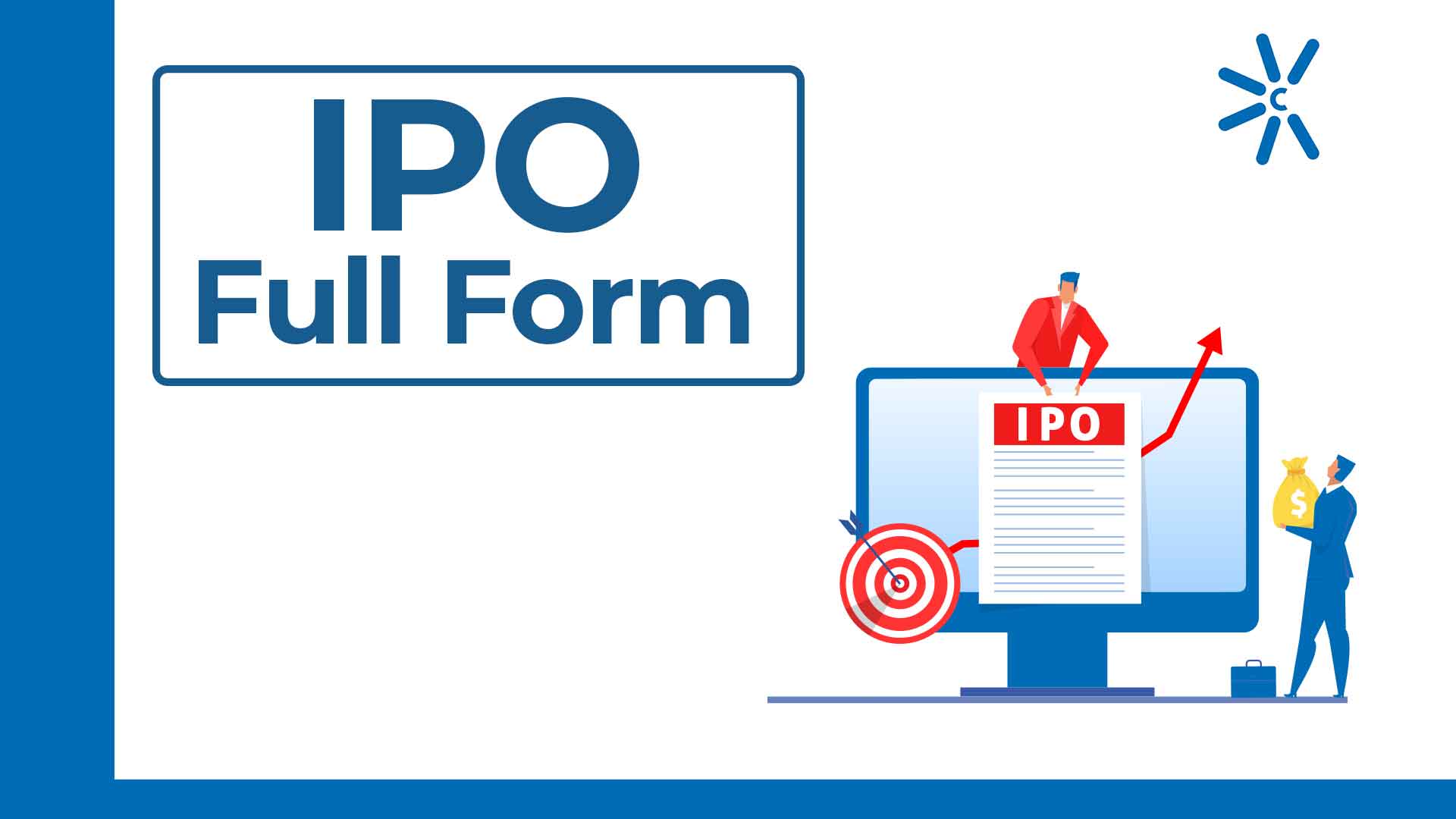IPO Full Form

- Published Date: December 21, 2021
- Updated Date: June 17, 2025
- By Team Choice
The full form of IPO is Initial Public Offering.

The name of IPO reveals a lot about the meaning as well. It is the first step taken by a company to go ‘public’. It simply means that a company becomes eligible for getting listed on the stock exchanges.
There are various reasons why a company decides to go public. The primary motive, although, remains the same: raising capital. Now, this capital can be generated for covering operational costs, clearing debts, expanding business, purchasing machinery, etc.
Another reason for a company to go public is to increase its visibility. Once a company goes public, it is available for retail investors, increasing its popularity.
Let us now understand the meaning of IPO in detail.
Open a FREE Demat Account in 5 Mins.
- Free AMC for First Year
- Low DP Charges (₹ 10)
- No Auto Square Off Charges
- Free Research Advisory
IPO Meaning
Suppose you have a business in automobiles and you are planning to expand it to some more cities. But the problem here is that you don’t have sufficient capital for the same. What will you do in such a situation?
Either you approached investors to raise funds or avail of the bank loan. Right?
But have you thought of another way around, of going public?
IPO brings a solution to such queries. Initial Public Offering or IPO lets a private company bring out its shares to the stock exchanges. This allows the retail investors and other investors as well to become a part of the company. And the company gets the funding and visibility.
There is a whole procedure for a company to launch its IPO. The initial step is the approval of SEBI. Then, after the company provides all the details and SEBI gives the nod, it is only after that the advertisements and announcements go out.
There are various other terms associated with IPO; let us quickly have a look at them as well but before that keep in mind Investors always look for new opportunities to make significant profits. And IPOs have always been a center of attraction for not just beginner traders but also experienced ones. To understand the concept of IPO better, it is essential to understand the IPO full form.
IPOs are a gateway for companies to get listed on the stock market and avail themselves of the benefits and also for the investors. Therefore, if you are also looking to invest in IPO, it is vital to know the details of the full form of IPO and also how IPO works?
Let’s begin!
DRHP IPO Full Form
The full of DRHP is Draft Red Herring Prospectus.

Now, you must be wondering what exactly DRHP is? DRHP is a document that proposes an offer on behalf of the company that is ready to launch its IPO in the market.
The merchant bankers are responsible for drafting this offer document, and it is presented to SEBI.
In this document, the company provides all the information regarding the IPO. For example, it includes the objectives of the company, the amount that it intends to raise, the opening and closing dates, etc.
Other than this, the information that makes this document important is the fundamental information (income statement, balance sheet, and annual report) and other future goals of the company.
SEBI goes through the DRHP and suggests changes if necessary. It also contains all the financial information of the company, the name of the investors, etc.
Going through the DRHP can help an investor decide whether to apply for an IPO or not.
ASBA IPO Full Form

Another common term associated with IPO application is ASBA. The full form of ASBA is Application Supported by Blocked Amount.
It is a process of application of IPO, in which the amount is blocked in the account till the time of the IPO allotment.
How does it work? So whenever you are applying for an IPO, the amount is not debited from your account since there is no guarantee of you getting the allotment.
So, when the IPO is allotted to you, the amount is debited from your account. However, just in case the IPO is not allotted to you, the amount is unblocked for your use.
Even in case if you were wondering, is IPO safe or not? Then the answer is that you don’t have to worry about your money getting debited for no reason, and it is absolutely secure.
Therefore, applying for IPO through ASBA is the best way for submitting your application.
GMP IPO Full Form

Another important term used is the GMP, the full form of which is Grey Market Premium.
Now, if you have ever applied for the IPO you might have heard about the GMP being higher and the IPO being great in return.
Grey market premium is the extra amount that an investor is willing to pay on top of the price band in the grey market. The Grey market is where the IPO shares are unofficially traded.
Thinking, why GMP is important in IPO?
Well, the value of the GMP of an IPO helps in deciding the benefits one can gain on a listing day. A lot of investors look at the premium before deciding whether to apply for the IPO or not. The better the GMP, the better the chances of listing gains.
For example- The price of an IPO share is ₹300, and the GMP is ₹200, this means that an investor is willing to pay ₹500/share for the shares going to list in the IPO, instead of ₹300.
Before you sell IPO in grey market it is important to learn the process of how to calculate GMP of IPO to avoid any confusion or losses.
The GMP of an IPO is highly influenced by the demand for the IPO in the market; therefore, it plays a crucial role in the investor’s decisions.
Conclusion
The IPOs have been in bloom ever since the beginning of this year and have managed to generate a lot of capital.
But, as the full form of IPO suggests, it is the company’s initial step to getting visible to the public. It is only after the floating IPO that a company gets listed in the stock market.
If you also want to apply for an IPO, open your Demat account today!
Recommended for you

Pre Apply IPO Benefits

Defence & Aerospace Crucial for आत्मनिर्भर BHARAT

Why Have Mutual Funds Become A Go-To Investment Choice in Recent Times?
